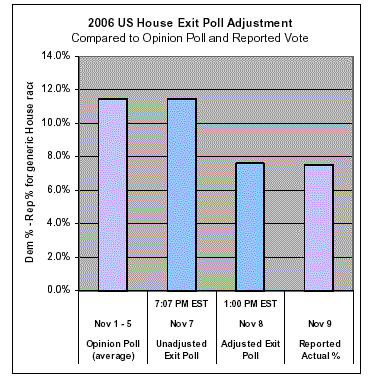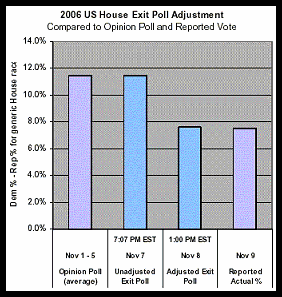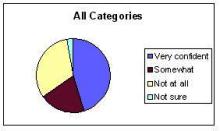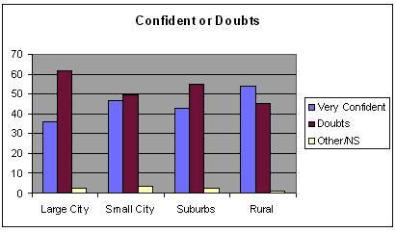Under-sampling of Democrats in the House Exit Poll
and the Corruption of the Official Vote Count
Jonathan Simon, JD, and Bruce O’Dell1
Election Defense Alliance
Introduction: Pre-Election Concern, Election Day Relief, Alarming Reality
There was an unprecedented level of concern approaching the 2006 Election (“E2006â€) about the vulnerability of the vote counting process to manipulation. With e-voting having proliferated nationwide, and with incidents occurring with regularity through 2005 and 2006, the alarm spread from computer experts to the media and the public at large. It would be fair to say that America approached E2006 with held breath.
For many observers, the results on Election Day permitted a great sigh of relief—not because control of Congress shifted from Republicans to Democrats, but because it appeared that the public will had been translated more or less accurately into electoral results, not thwarted as some had feared. There was a relieved rush to conclude that the vote counting process had been fair and that the concerns of election integrity proponents had been overblown.
Unfortunately the evidence forces us to a very different and disturbing conclusion: there was gross vote count manipulation and it had a great impact on the results of E2006, significantly decreasing the magnitude of what would have been, accurately tabulated, a landslide of epic proportions. Because virtually all of this manipulation appears to have been computer-based, and therefore invisible to the legions of at-the-poll observers, the public was informed of “isolated incidents and glitches†but remains unaware of the far greater story: The electoral machinery and vote counting systems of the United States did not honestly and accurately translate the public will and certainly can not be counted on to do so in the future.
The Evidentiary Basis
Our analysis of the distortions introduced into the E2006 vote count relies heavily on the official exit polls once again undertaken by Edison Media Research and Mitofsky International (“Edison/Mitofskyâ€) on behalf of a consortium of major media outlets known as the National Election Pool (NEP). In presenting exit poll-based evidence of vote count corruption, we are all too aware of the campaign that has long been waged to discredit the reliability of exit polls as a measure of voter intent. Our analysis is not, however, based on a broad assumption of exit poll reliability. We maintain only that the national exit poll for E2006 contains within it a specific question that serves as an intrinsic and objective yardstick by which the validity of the poll’s sample can be established, from which our conclusions flow directly.
For the purposes of this analysis our primary attention is directed to the exit poll in which respondents were asked for whom they cast their vote for the House of Representatives. 2 Although only a few House races were polled as individual races, an additional nationwide sample of more than 10,000 voters was drawn,3 the results representing the aggregate vote for the House in E2006. The sample was weighted according to a variety of demographics and had a margin of error of +/- 1%.
When we compare the results of this national exit poll with the total vote count for all House races we find that once again, as in the 2004 Election (“E2004â€), there is a very significant exit poll-vote count discrepancy. The exit poll indicates a Democratic victory margin nearly 4%, or 3 million votes, greater than the margin actually recorded by the vote counting machinery. This is far outside the margin of error of the poll and has less than a one in 10,000 likelihood of occurring as a matter of chance.
___________________________________________________________________________________________
1 Jonathan Simon, JD (http://www.electiondefensealliance.org/jonathan_simon) is Co-founder of Election
Defense Alliance. Bruce O’Dell (http://www.electiondefensealliance.org/bruce_odell) is EDA Data
Analysis Coordinator.
2 Edison/Mitofsky exit polls for the Senate races, which also present alarming discrepancies, will be treated
in a separate paper.
3 The sample size was roughly equal to that used to measure the national popular vote in presidential
elections. At-precinct interviews were supplemented by phone interviews where needed to sample early
and absentee voters.
_____________________________________________________________________________________________
Did The 2006 Exit Poll Oversample Democrats?
An Intrinsic Yardstick Answers This Question
In E2004 the only nontrivial argument against the validity of the exit polls—other than the mere assumption that the vote counts must be correct—turned out to be the hypothesis, never supported by evidence, that Republicans had been more reluctant to respond and that therefore Democrats were “oversampled.”4 And now, in E2006, the claim has once again been made that the Exit Polls were “off” because Democrats were oversampled. Indeed this claim is by now accepted with something of a “so what else is new?†shrug. The 2006 Exit Poll, however, contains an intrinsic yardstick that directly refutes this familiar claim.
Because the NEP envisions the post-election purpose of its exit polls as being limited to facilitating academic dissection of the election’s dynamics and demographics (e.g., “How did the 18-25 age group vote?†or “How did voters especially concerned with the economy vote?â€), the NEP methodology calls for “adjusting” its exit polls to congruence with the actual vote percentages after the polls close and actual returns become available. Exit polls are “adjusted” on the ironclad assumption that the vote counts are valid. This becomes the supreme truth, relative to which all else is measured, and therefore it is assumed that polls that match these vote counts will present the most accurate information about the demographics and voting patterns of the electorate.
Logic tells us that if such an adjusted poll yields obviously inaccurate and distorted information about the demographics and voting patterns of the electorate, then the vote count it was forced to match is itself invalid—and quantifiably so.
______________________________________________________________________________________________
4 See for example David Bauder, AP, in a November 8 article at http://www.washingtonpost.com/wpdyn/
content/article/2006/11/08/AR2006110800403.html . Oddly enough, ?oversampling? of Democrats has
become a chronic condition of exit polls since the proliferation of e-voting, no matter how diligently the
nonpartisan collection of experts at the peak of their profession strives to prevent it.
5 Any informed discussion of exit polling must distinguish among three separate categories of data: 1)
“Raw” data, which comprises the actual responses to the questionnaires simply tallied up (this data is never
publicly released and, in any case, makes no claim to accurately represent the electorate and can not be
usefully compared with vote counts); 2) “Weighted” data, which has been weighted or stratified on the
basis of several demographic and voting pattern variables to reflect the electorate as accurately as the
pollsters can manage with the extensive information they possess; and 3) “Forced” or “adjusted” data, in
which the pollster overrides all previous weighting in order to make the “Who did you vote for?” result in a
given race match the vote count for that race, however it distorts the demographics of the sample (that’s
why they call it “forcing”).
6 The 7:07 p.m. exit poll, as posted on CNN.com, reported a 10,207 sample size and, in accordance with
NEP methodology, the raw data had been weighted to closely match the demographics of the electorate.
_____________________________________________________________________________________________
The E2006 exit poll itself contains a “background” question which serves as an intrinsic measuring stick to allow us to put this claim to a very objective test. Respondents were asked for whom they voted in the 2004 presidential election.
Because this very telling intrinsic yardstick was included in the 2006 Exit Poll, it provides an objective basis to assess whether Democratic and Republican voters actually were sampled and weighted in correct proportions. In fact it reveals that Democrats won by a 4% greater margin than indicated by the actual vote count.
In the 2004 election, Bush’s margin was 2.8%. The 2006 exit poll results as of 7:07 p.m. on Election Night recorded a comparable 2% margin among respondents asked for whom they had voted in 2004, 45% Kerry to 47% Bush. This is a very strong indicator that the exit poll, on the evening of November 7th, accurately reflected the official 2006 outcome as a whole. The 2006 national vote for the House, as captured by this weighted but unadjusted Election Night exit poll, was 55.0% Democratic and 43.5% Republican, an 11.5% Democratic margin.
By 1:00 p.m. on Wednesday, November 8th, the final adjusted exit poll reported the overall vote for the House was 52.6% Democratic and 45.0% Republican. This was a 7.6% margin that matched the overnight preliminary 2006 election results tally, but was 3.9% smaller than that recorded by the 7:07 p.m. Election Night poll.
Yet for the same question—“For whom did you vote in the 2004 presidential election?”—the final, adjusted exit poll showed a margin of 43% Kerry to 49% Bush. This 6% margin in favor of Bush was a dramatic distortion of the 2.8% margin actually recorded in E2004.7
In the process of adjustment (or “forced weighting”) to make the poll results equal or mirror the reported vote results, the sample had to be distorted, by giving less weight to the respondents who said they had voted for a Democratic candidate and more weight to the respondents who said they had voted Republican.
In order to match the results of the official tally, the 2006 exit poll adjustment was so extensive that it finally depicted an electorate that voted for Bush over Kerry by a 6% margin in 2004: very clearly an undersampling of Democrats and an oversampling of Republicans.8

See Appendix 1 for detailed tabular presentation of the above data.
____________________________________________________________________________________________
7 While we present the reported 2.8% Bush margin in 2004 at face value, it will not escape notice that the
distortions in vote tabulation that we establish in the current paper were also alleged in 2004, were
evidenced by the 2004 exit polls, and were demonstrably achievable given the electronic voting systems
deployed at that time. We note that, if upon retrospective evaluation the unadjusted 2004 exit polls were as
accurate as the 2006 exit polls have proven to be, and their 2.5% margin for Kerry in 2004 is taken as the
appropriate baseline, a correctly weighted sample in 2006 would have included even more Kerry voters and
even fewer Bush voters than Edison/Mitofsky?s 7:07 p.m. poll, with a substantial consequent up-tick in the
Democratic margin.
8 The distortion is introduced because every “I voted for the Democrat for the House” questionnaire is
given a decreased weight necessary to bring the total Democratic vote down to the official reported
percentage, and every “I voted for the Republican” questionnaire is given an increased weight needed to
bring the total Republican vote up to the official reported percentage. That weighting also affects equally
the response to every question on the questionnaire, including of course the “Who did you vote for in the
presidential election of 2004?? question. That is how the results for that question went from 47%-45%
Bush in the weighted but unadjusted poll to 49%-43% Bush in the adjusted poll posted the next day.
_____________________________________________________________________________________________
What Really Happened On November 7th?
If the final and official exit poll numbers so grossly oversampled Republicans and undersampled Democrats in order to force a match of the overall numbers to the aggregate House vote tally reported on November 8th, then we must conclude that the valid exit poll was the unadjusted exit poll – from 7PM the previous evening – that gave us very nearly the correct proportions of Kerry and Bush voters.
That unadjusted poll indicated that the Democrats’ 2006 total House vote margin was 11.5%, or nearly 4% greater than the 7.6% reported vote count margin.9 This represents nearly a three million vote discrepancy between the validated exit poll results and the reported vote tally for the US House of Representatives. What could account for such a dramatic difference?
_______________________________________________________________________________________________
9 The 11.5% Democratic margin indicated in the unadjusted exit poll early on Election Night also was
consistent with the average of the major ?Generic House? public opinion polls conducted immediately prior
to the election. In fact, the 11.5% margin was substantially smaller than predicted by all but two ?outlier?
polls. nal_ballot-22.html…. It is
worth noting that virtually all of the pre-election polls shift, in the month before the election, to a “likelyvoter
cutoff model” (LCVM) that excludes entirely any voters not highly likely (on the basis of a battery of
screening questions) to cast ballots; that is, it excludes entirely voters with a 25% or even 50% likelihood of
voting. Since these are disproportionately transients and first-time voters, the less educated and affluent, it
is also a correspondingly Democratic constituency that is disproportionately excluded. Ideally these voters
should be down-weighted to their estimated probability of voting, but that probability is not 0%. By
excluding them entirely, these pre-election polls build in a pro-Republican bias of about 2-5%. Dr. Steven
Freeman, visiting professor at the University of Pennsylvania’s Center for Organizational Dynamics, has
examined this phenomenon in great detail. Of course, one of the reasons for the recent shift to the LVCM–
a methodology that pollsters will generally admit is distorted but which they maintain nonetheless ?gets it
right?–is that pollsters are not paid for methodological purity, they are paid to get it right. The reality is
that distorted vote counts and a distorted but ?successful? pre-election polling methodology are
corroborating and validating each other, with only the exit polls (drawn from actual voters) seeming out of
step.
10 Consequently even the unadjusted exit poll, which fit the contours of the 2004 electorate, very likely
undersampled the Democrats voting in E2006. Indeed, once the on-going analysis fully quantifies the
extent of the Democrats’ turnout victory, it will be time to recalculate upward the extent of the vote
miscount in 2006. Our estimates, impounding the several exacerbating factors we have noted, put the likely
Democratic victory margin in the total House vote at more than 20% (61% – 38%).
_______________________________________________________________________________________________
Differential turnout?
While it could be argued that a sample with a 6% Bush > Kerry voter margin might be valid because Republicans turned out in droves and routed the Democrats in the E2006 turnout battle, there are a plethora of measures, including individual precinct tallies, that indicate the obvious: the Democrats clearly won the Get-Out-The-Vote battle; in fact many Republican voters stayed home, dismayed and turned-off by the late-breaking run of scandals, bad news, and missteps.10
The Democrats clearly won the turnout battle and yet the only way that the adjusted exit poll could be valid is to postulate a disproportionately Republican electorate that favored Bush by 6% rather than 2.8% in 2004, clearly a contradiction.
Vote count discrepancy?
If the weighted but unadjusted Election Night exit poll is valid as indicated, then it must be the reported vote tally which is inaccurate.11 Although this is, to put it mildly, an unwelcome finding, it is unfortunately consonant with analyses we are currently performing of the many specific incidents of vote-switching and mistabulation reported in 2006, and with a host of other evidence and analysis that has emerged about electronic voting technology as deployed in the United States.
We have argued that there is a remarkable degree of consensus among computer scientists,12 security professionals,13 government agencies,14 and independent analysts15 that U.S. electronic vote tallying technology is vulnerable to unintentional programming errors16 and to deliberate manipulation—certainly by foul-play-minded insiders at voting equipment vendors, but also by other individuals with access to voting equipment hardware or software.17
We have a system of “faith-based†voting where we are simply asked to trust the integrity of the count produced by the machines that tally our votes, with little if any effective checks and balances. In the context of yet another election replete with reported problems with vote tallying,18 the continuing mismatch between the preferences expressed by voters as captured in national exit polls, and the official vote tally as reported to the public is extremely disturbing.
Conclusion
While the reported results of the 2006 election were certainly well-received by the Democratic party and were ballpark-consistent with public expectations, the unadjusted 2006 exit poll data indicates that what has been cast as a typical midterm setback for a president in his second term was something rather more remarkable – a landslide repudiation of historic proportions.
We believe that the degree of statistical distortion now required to force exit polls to match the official tally is the clearest possible warning that the ever-growing catalog of reported vulnerabilities in America’s electronic vote counting systems are not only possible to exploit, they are actually being exploited.
Any system so clearly at risk of interference and gross manipulation can not and should not be trusted to tally the votes in any future elections.
_______________________________________________________________________________________________
11 It will no doubt be objected that if such substantial manipulation of the vote counts is possible, why
would it stop short of bringing about a general electoral victory? While we would like to credit the
heightened scrutiny engendered by the untiring efforts of election integrity groups, an awakening media,
and a more informed and vigilant public, an alternative, more chilling, explanation has been suggested?
simply that the mechanics of manipulation (software modules, primarily) had to be deployed before latebreaking
pre-election developments greatly expanded the gap that such manipulation would have been
calibrated to cover.
12 For instance http://www.acm.org/usacm/weblog/index.php?cat=6
13 See the credentials of the interdisciplinary Brennan Center Task Force membership at
http://brennancenter.org/dynamic/subpages/download_file_36343.pdf
14 http://www.gao.gov/new.items/d05956.pdf
15 See http://www.blackboxvoting.org/BBVtsxstudy.pdf, http://www.blackboxvoting.org/BBVtsxstudysupp.pdf, and http://www.blackboxvoting.org/BBVreport.pdf
16 Credible reports of voting equipment malfunctions are all too common; one good starting point is
http://www.votersunite.org/info/messupsbyvendor.asp
17 For example http://brennancenter.org/programs/downloads/SecurityFull7-3Reduced.pdf
18 Election 2006 incidents at http://www.votersunite.org/electionproblems.asp
_______________________________________________________________________________________________



From Election Defense Alliance













